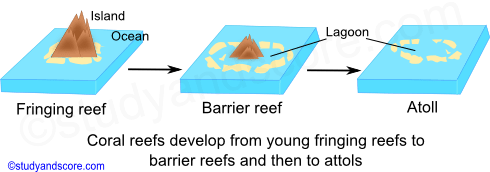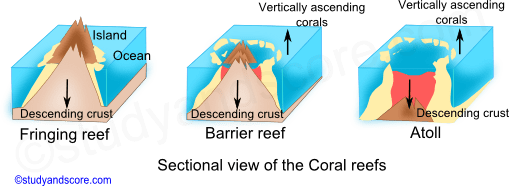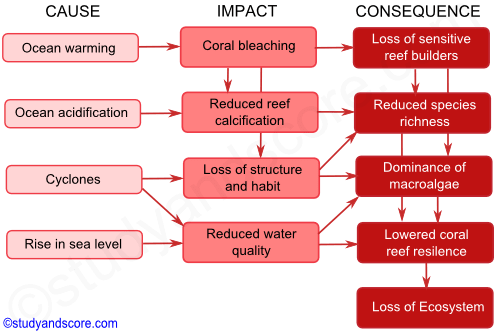The coral animals are marine, colonial polypoid Coelenterates. They look like the miniature sea anemones living in the skeleton secreted by them. The calcareous (Calcium carbonate) and horny skeleton secreted by the coral animals is commonly called as coral.
Some of the corals grow into massive, solid structures and few other form large and branched colonies. These coral animals belong to the class Anthozoa and also few species of the class Hydrozoa are also known to form corals.
Structure of a coral polyp: A typical coral polyp is a small organism of about 10mm long and 1-3 mm in diameter. Few solitary polyps also reach to a diameter of 25 cm. Basal disc is absent in these coral polyps as the basal region is surrounded by calcareous exoskeleton.
The oral disc bears numerous tentacles in several rows around the oval or circular mouth. Pharynx is short with no siphonoglyphs. Mesenteries are restricted only to the upper part of the polyp. The mesenterial filaments have glandular lobe bearing nematocysts. Muscles are not well developed. Living polyps are found only on the surface layers of the coral mass. Feeding type is both raptorial and suspension.
Structure of Coral skeleton: The skeleton of a solitary coral is known as corallite. This skeleton is a calcareous structure secreted by the epidermis. In a colonial coral, corallites are the individual polyps which fuse with one another to form a skeletal mass called corallum.
Each corallite is stony cup with a basal plate. The cup wall is called as theca. The cavity of the cup consists of a number of vertically radiating ridges called sclerosepta. The sclerosepta proceeds from theca towards the center of the cup. The inner ends of sclerosepta are fused to form irregular central skeletal mass or columella.
Formation of coral skeleton: In all the coral polyps the sexual reproduction takes place by the fusion of gametes. Zygote develops into a free-swimming ciliated planula larva which after a short spell of swim gets attached to a substratum. This settled planula larva metamorphoses into a young coral polyp. There is no medusa stage in corals. By the method of asexual budding the single parent becomes the parent of all the other members of the colony.
This coral polyp begins to secrete a skeletal rudiment called prototheca by the ectoderm. After this secretion, radial folds develop which in turn secrete sclerosepta. At the same time a rim is built at the thecal wall around the polyp. In the meantime, further skeletal material is added into the gaps existing between the sclerosepta of the skeleton.
By the budding of the new polyps, the coral colony grows in size continuously along the margins and on the surface. The structural differences and variations in the coral colony is the result of the patterns of the budding.
The continuous budding of the coral polyps makes them grow enormously and form massive structures called as coral reefs. According to Wayland Vaughan, an American geologist and oceanographer, a coral reef is a ridge of limestone, the upper surface of which is near the surface of the sea. The coral reefs are formed of calcium carbonate secreted by the coral polyps. The main contribution to the coral reef formation is by stony corals. Also coralline algae and foraminiferans (Protozoan) take part in the formation of the coral reefs.
Distribution of coral reefs: For the activity of coral building the corals need warm shallow waters at the temperature above 20oC. Hence the corals are found only at Indo-Pacific, Central-Western Pacific and Caribbean regions.
Kinds of Coral reefs: Depending on their formation, coral reefs are of three kinds.
Fringing reefs-The coral reefs situated close to the shores of some volcanic islands or part of some continent are called as fringing reefs. A typical fringing reef may extent to a distance of quarter mile from the shore with the most active zone of the coral growth facing the sea. This sea ward zone is called as the edge or the front. A shallow water channel of about 50-100 meters width lies between the reef edge and the shore. During the low tide, the water channel recedes exposing a flat bottom surface called reef flat. The reef flat is composed of sand, mud, dead and living coral colonies and other animals too.
Barrier reefs- Though similar to fringing reefs, barrier reefs are situated at some distance away from the shore. The stretch of water, separating the barrier reef from land, may be half a mile to 10 miles. This stretch is called lagoon. The lagoons are 10-50 fathoms deep and are best suited for navigation.

Atolls- These atolls are also known as coral islands or lagoon islands. They are ring-like or horseshoe-shaped reefs which encircle a lagoon. The lagoon may be complete or broken by a number of channels of which only a few are navigable. Outer side of the reef slopes off into the depth of the ocean. The atoll of Bikine which is famous for hydrogen and atomic bomb tests is situated in the Pacific Ocean
Formation of Coral reefs: Many theories have been put forth to explain the formation of the coral reefs but only few have been satisfactory. The following are the theories which satisfactorily explain the formation of the coral reefs.
Subsidence Theory- This theory is put forth by Darwin. According to this theory, all known coral reefs are found in regions where subsidence of land has taken place. He reasons that, initially the corals grew as fringing reef on the sloping shores of an island in a shallow tropical sea. Subsidence of the islands commenced so that the fringing reef turned into barrier reef, separated from the island by a wide, deep water channel or the lagoon. The island, while sinking became smaller and smaller and finally disappeared entirely beneath the surface of the ocean.
Theory of sea bottom rise: Sir John Murray advanced the view that the corals grow on the highest peaks of the ocean bottom. The deposition of sediments brings them to an optimum level for coral growth. The barrier reefs and atolls are produced by the better growth of the corals on the edges of the coral deposition and through solution of inner coral rock.

Glaciation control Theory: The theory was propounded by Albrecht Penck and Reginald Daly. They advocated that during glacial period formation of ice-caps lowered the level of ocean by 60-70 m. At that time extreme cold temperature prevailed. Subsequently ice melted and the temperature rose. The corals began to grow on the flat platform of the ocean bottom and kept pace with rising levels of the ocean forming gigantic reefs.
As coastal construction increases and global temperatures rise corals are in danger extinction. Marine studies have shown a decline in some forms of coral over the last decade. Coral reefs are the unseen backbones of the Earth’s ecosystem. With almost a quarter of sea life making their homes in coral reefs, coral reef health is a key to a robust ecosystem. The following are the main causes of destruction of coral reefs,
Reef Bleaching: Reef bleaching occurs when water conditions cause coral to expel the internal microorganisms that give corals their vibrant colors. Bleaching events are caused by a number of factors including an increase in water temperature. As global warming warms the planet, ocean water temperatures are also on the rise. With warmer waters, bleaching events have become more common.
Poison Fishing: It is unfortunately common practice to use cyanide and other poisons to fish for coral reef dwelling creatures. The poison is not designed to necessarily kill the desired catch, but is used to stun fish that will then be used in domestic salt water aquariums. Although many fish can metabolize the cyanide and are only temporarily harmed by its effects, the same is not true for coral polyps. When the cyanide is released in the nooks and crannies of the reef, the coral often dies in the cloud of poison.
Water Pollution: Water pollution is perhaps the most obvious cause of coral reef destruction. Reefs are harmed when oil, fertilizer, human and animal waste are dumped in the area. Not only do these elements change the chemical make-up of the water, waste can also block life-giving sunlight to the reef. Large floating trash can cut young coral polyps off from nutrients they need to grow into a thriving reef.
Sedimentation: Construction and mining along sea coasts can create a great deal of silt and soil run off. Particles that enter the ocean can smother coral reefs, depriving them of sunlight and nutrients. Fish are unable to feed and coral polyps are unable to grow leaving the area inhospitable to reef life.
Careless tourism: Much destruction to coral reefs could be prevented with just a bit of education for those who want to explore these interesting natural creations. Divers, snorkelers and other sea lovers often inadvertently damage the reef. By simply touching coral the oils on human fingers can kill whole areas of coral reefs. Boating and fishing can also damage coral reefs with carelessly dropped anchors or lines.
Coral reef ecosystems are threatened around the world. As a result, many marine conservation Programmes have been designed which aim to study and conserve coral reefs. Education, outreach and community engagement are often a key component of conservation Programmes and can help to reduce a number of threats, such as over-fishing and land-based pollution.

Marine Protected Areas are one of the most effective ways to protect and restore coral reef ecosystems. Research and monitoring of coral reefs is also vitally important in ensuring that the world’s reefs remain healthy. Initiatives such as Coral Reef Watch (CRW) use satellite data on sea surface temperature to alert scientists and conservationists about the possible coral bleach.
The Great Barrier Reef is the largest coral reef in the world based on both area and length.
The following is a list of the world’s ten largest coral reefs:

- Share with your friends! -
Login to post your comment here...
- or with social Account -